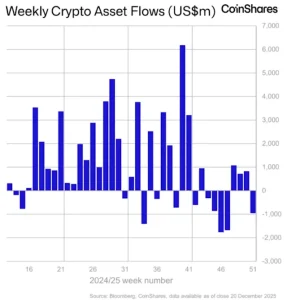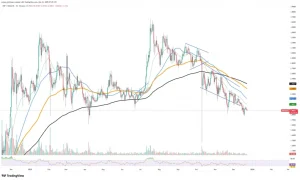BlackRock’s Rs. 5,600 Crore Crypto Unload: What the $673 Million Bitcoin and Ethereum Move Reveals About Institutional Sentiment

In a move that has stirred deep discussions across global financial markets, BlackRock, the world’s largest asset management firm, has transferred over $673 million (approximately Rs. 5,600 crore) worth of Bitcoin and Ethereum to an exchange-linked custody account. The transaction, involving thousands of coins from both digital assets, has led to widespread speculation about whether this represents a strategic rebalancing or an early sign of institutional caution. As crypto markets grapple with volatility and regulatory pressure, this shift underscores the growing sophistication — and sensitivity — of institutional participation in the digital asset space.
Institutional Reshuffle: A Closer Look at the $673 Million Transfer
Blockchain data indicates that BlackRock offloaded around 4,653 Bitcoin and 57,455 Ethereum, collectively worth over $673 million. These digital assets were moved to a high-security custodial account connected to a major U.S.-based exchange. While the transaction does not automatically confirm a direct sell-off, such large-scale movements by an institutional player of this magnitude typically signal portfolio restructuring or liquidity management ahead of market shifts.
The transfer followed another notable movement — roughly 34,700 Ethereum (valued near $115 million) — just a day earlier, suggesting a pattern of strategic repositioning. The transactions were executed in organized batches, indicating that they were likely planned as part of an operational shift rather than an impulsive trade.
Market Interpretations: What BlackRock’s Move Might Mean
1. Strategic Portfolio Adjustment
For a firm managing trillions of dollars in assets, even a $673 million transaction may represent a tactical repositioning rather than a bearish exit. Analysts suggest that BlackRock could be rebalancing its digital asset exposure to accommodate inflows and redemptions within its crypto-linked investment products or ETFs.
Such adjustments are common in institutional asset management, particularly when volatility spikes. By reallocating crypto holdings to custodial platforms, firms can optimize liquidity while retaining flexibility for quick re-entry should market sentiment shift.
2. Sign of Institutional Prudence
The timing, however, raises eyebrows. The crypto market has recently experienced increased volatility amid global macroeconomic uncertainty and fluctuating interest rate expectations. BlackRock’s move could therefore reflect a cautious approach to market risk — reducing exposure to speculative assets ahead of potential downside scenarios.
For institutions, crypto allocations often serve as asymmetric hedges rather than core holdings. A temporary retreat, in this context, may represent prudent capital management rather than loss of conviction in the sector’s long-term potential.
3. Investor Psychology and Market Reaction
Large institutional transfers like this often ripple through investor sentiment. When a heavyweight such as BlackRock appears to be exiting positions, retail investors may interpret it as a warning sign, accelerating short-term sell-offs. However, seasoned market participants typically view such moves as liquidity adjustments, often followed by reaccumulation at lower price levels.
This dichotomy between perception and reality is what fuels volatility — a recurring feature of crypto markets where institutional activity amplifies retail behavior.
Why This Move Is Important Beyond the Numbers
Institutional Footprint in Crypto Evolution
BlackRock’s involvement in digital assets over the past few years has been viewed as a barometer of mainstream acceptance. From launching Bitcoin ETFs to exploring blockchain-based tokenization, the firm has steadily deepened its footprint in the sector. Hence, any major reallocation becomes symbolically significant, reflecting shifts in institutional attitudes toward risk and opportunity.
The $673 million transfer, while large, may signal that institutions are now managing crypto exposure with the same discipline and flexibility applied to equities, bonds, and commodities. This maturation of strategy indicates that crypto is transitioning from speculative novelty to a recognized — though volatile — asset class.
Market Liquidity and Price Implications
If the assets are indeed being prepared for sale, the short-term impact on market liquidity could be meaningful. A sale of this magnitude would add selling pressure, potentially pushing prices lower temporarily. However, the liquidity of Bitcoin and Ethereum remains robust compared to smaller tokens, minimizing systemic risk.
For traders, this episode highlights the importance of tracking institutional flows, which increasingly dictate price direction and volatility patterns in major cryptocurrencies.
Broader Implications: Reading the Institutional Playbook
1. Risk Management in a Shifting Macro Environment
Institutions are navigating an environment defined by inflation concerns, shifting monetary policies, and tighter liquidity. In such conditions, reducing exposure to high-volatility assets like crypto is consistent with conservative risk management practices.
2. Potential Preparation for Regulatory Change
With global regulators sharpening their focus on digital asset transparency and compliance, large firms may also be repositioning assets to align with evolving frameworks. Moving holdings into exchange-custodied accounts could facilitate reporting, auditing, or settlement processes that comply with new disclosure standards.
3. Signal of Market Maturity
Rather than a flight from crypto, this may reflect an emerging phase of institutional discipline. As digital assets integrate more deeply into traditional finance, portfolio managers are treating them like any other asset — adjusted, hedged, and rotated based on macroeconomic outlooks and liquidity cycles.
The Takeaway: A Turning Point, Not a Retreat
BlackRock’s Rs. 5,600 crore crypto transfer should not be seen as an indictment of Bitcoin or Ethereum’s long-term potential. Instead, it underscores the institutional normalization of crypto asset management — where major players apply conventional portfolio logic to digital markets.
Short-term volatility may persist as markets digest the signal, but in the long run, such disciplined moves by asset managers could strengthen the sector’s credibility. Crypto’s future will be defined less by speculative enthusiasm and more by measured, strategic participation from global financial leaders.
In that sense, this event is not a warning of collapse — it’s evidence that digital assets have entered the boardrooms of serious money managers, where every move is calculated, deliberate, and globally consequential.






